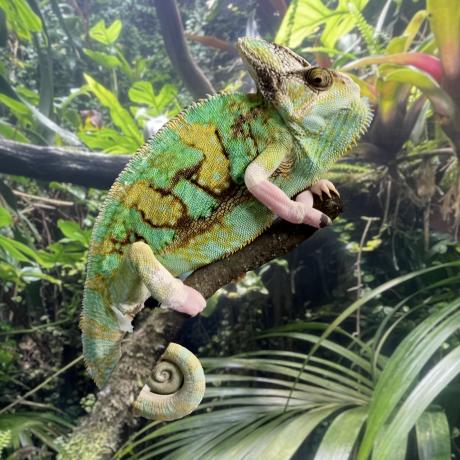

The Yemen or Veiled Chameleon as its also known, is one of the best reptiles for beginners. However this species still requires an amount of specialist care.
| Origin | Saudi Arabia |
|---|---|
| Environment | Humid forests |
| Adult Size | 20 - 30cm Body |
| Suitability | Beginner |
| Lifespan | 4 - 8 years |
| Food Type | Omnivore |
Veiled Chameleons are sexually dimorphic, which means that as adults the male and female of this species look different and are therefore easily distinguishable. An adult male is somewhat larger than the female, and is usually of varying shades of green, with 3-5 yellow/orange vertical bands on its back, and sides, as well as other markings which can develop anywhere on the body, and can be blue, dark green, orange, brown, red, yellow… pretty much any colour. The most striking feature of a male Yemen Chameleon is its large crest on top of its head. This is also coloured green with blue or darker green/yellow striping.
The females are less colourful and lack the large crest, although they do have a small crest and when in breeding season can develop striking blue markings around their head and legs. The easiest way to sex a baby/juvenile Yemen that is yet to develop either the crest or adult colouration is to look at the hind feet. If there is a spur at the heel of the feet, then it is most likely male. If there is no spur, it is female. Once you have examined both sexes of this species closely you can easily distinguish between the sexes.
They are also equipped with a rather fantastic prehensile tail, which wraps around anything it can to aid with balance and feeding.
As the name suggests the Veiled or Yemen chameleon is from the Yemen area, and across Saudi Arabia. Being from this location means that particular attention to detail is needed with regard to their captive environment.
Yes, if you look after it how it should be looked after.
Being from Saudi Arabia, this chameleon needs relatively high temperatures. It is also advisable to give it an arboreal vivarium, as they spend most if not all their time in trees and vegetation. The minimum cage requirements for a single adult are 4' H x 2' D x 2' L. The best way to provide heat is with an incandescent basking light bulb, of course on a thermostat. The temperatures you should be aiming for are 95° F - 105° F at the basking point, with the cool side being at most 15° F cooler. At nighttime these temperatures can be dropped by 10-15° F. UV lighting is essential with these lizards. A 5.0 or 8.0 % UV bulb is required on for 12-14 hours a day in the summer and 8-10 hours a day in the winter.
One of the most important factors in the successful keeping of this animal is its humidity requirements. Although there is little rainfall in Saudi Arabia, these chameleons favour where the insects spend most of their time, around water holes and pools. It is therefore important to mist the cage lightly a couple of times a day, making sure that you do not drench the cage that is. Humidity should be kept at 50-60%. Chameleons will rarely drink from standing water so it is therefore necessary to either spray the foliage in its cage so it can drink the droplets, or construct an in cage sprinkler system. This can be anything from a commercial dripper, to a hosepipe connected to a water supply with holes in it. However you decide to provide this humidity you must make sure that there is adequate ventilation in the cage, because lack of ventilation can cause bacteria growth and will end up making your chameleon ill, possibly causing respiratory disease.
One thing to note is that these Chameleons are NOT to be housed together, especially the males. Even the sight of its reflection in the glass can set off a male Chameleon. It will start displaying very bright colours, puff out its chin and suck in its belly making himself look as big as possible, then his tail will start curling up and flicking out. This can be very stressful to a chameleon and can sometimes cause it to stop feeding.
Feeding this Chameleon is relatively easy as long as you have access to live foods. Foods that can be offered are:
Crickets, locusts, mealworms, wax worms/moths, earthworms, flies, silkworms/moths and pinkie mice (when adult). Gut loading of all live food is essential. Foods suitable for gut loading live foods are carrots, sweet potatoes, collard greens, mustard greens, broccoli, spinach, apples, oranges, and cereals.
Some adults will also eat plant material. If you wish to you can hang a bunch of greens or watercress to the side of the tank. If they eat it that is great, if they don't then don't worry, it is not a necessity.
A varied diet is always best in any animal, these are no exception. Supplementation of this Chameleons diet is essential, especially with breeding females. They can easily suffer from metabolic bone disease, which is caused by lack of calcium. Supplement their diets with calcium and vitamin powder.
You must make sure that there is nothing in its tank that can harm it when feeding. As they shoot their tongues out at very fast speeds, they can easily damage it if they misjudge the distance, or try to eat something that is not food.
Substrate is not necessary in this Exotic Pets cage, as they spend no time on the floor, it is also safer as they may ingest some of it when feeding and become impacted.